Kashmiri Pandits
The Kashmiri Pandits (also known as Kashmiri Brahmins)[7] are a group of Kashmiri Hindus and a part of the larger Saraswat Brahmin community of India. They belong to the Pancha Gauda Brahmin group[8] from the Kashmir Valley,[9][10] a mountainous region located within the Indian union territory of Jammu and Kashmir. Kashmiri Pandits are Hindu Kashmiris native to the Kashmir Valley, and the only remaining Hindu Kashmiris after the large-scale of conversion of the Valley's population to Islam during the medieval times.[11][12] Prompted by the growth of Islamic militancy in the valley, large numbers left in the exodus of the 1990s. Even so, small numbers remain.
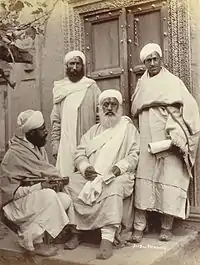 Kashmiri Pandits in Srinagar, c. 1895 CE | |
| Total population | |
|---|---|
| 300,000[1][2][3] to 600,000[4][5][6] (est. living in the Kashmir Valley prior to 1990) | |
| Regions with significant populations | |
| Historically: Kashmir Other communities: Jammu, National Capital Region • Ladakh • Uttar Pradesh • Himachal Pradesh • Uttarakhand • Haryana • Rajasthan • Indian Punjab | |
| Languages | |
| Sacred languages Sanskrit Ethnic language Hindi, Dogri, English | |
| Religion | |
| Related ethnic groups | |
| Kashmiris (Kashmiri Hindus, Kashmiri Muslims), Saraswat Brahmins |
History

Early history
The Hindu caste system of the Kashmir region was influenced by the influx of Buddhism from the time of Asoka, around the third century BCE, and a consequence of this was that the traditional lines of varna were blurred, with the exception of that for the Brahmins.[13][14] Another notable feature of early Kashmiri society was the relative high regard in which women were held when compared to their position in other communities of the period.[15]
A historically contested region, Northern India was subject to attack from Turkic and Arab regimes from the eighth century onwards, but they generally ignored the mountain-circled Kashmir Valley in favour of easier pickings elsewhere. It was not until the fourteenth century that Muslim rule was finally established in the Valley and when this happened it did not occur primarily as a consequence of invasion so much as because of internal problems resulting from the weak rule and corruption endemic in the Hindu Lohara dynasty.[16][17] Mohibbul Hasan describes this collapse as
The Dãmaras (feudal chiefs) grew powerful, defied royal authority, and by their constant revolts plunged the country into confusion. Life and property were not safe, agriculture declined, and there were periods when trade came to a standstill. Socially and morally too the court and the country had sunk to the depths of degradations.[17]
The Brahmins had something to be particularly unhappy about during the reign of the last Lohara king, for Sūhadeva chose to include them in his system of onerous taxation, whereas previously they appear to have been exempted.[18]
Medieval history
Zulju, who was probably a Mongol from Turkistan,[19] wreaked devastation in 1320, when he commanded a force that conquered many regions of the Kashmir Valley. However, Zulju was probably not a Muslim.[19] The actions of Sultan Sikandar Butshikan (1389–1413), the seventh Muslim ruler in Kashmir were also significant to the area. The Sultan has been referred to as an iconoclast because of his destruction of many non-Muslim religious symbols and the manner in which he forced the population to convert or flee. Many followers of the traditional religions who did not convert to Islam instead migrated to other parts of India. The migrants included some Pandits, although it is possible that some of this community relocated for economic reasons as much as to escape the new rulers. Brahmins were at that time generally being offered grants of land in other areas by rulers seeking to utilise the traditionally high literacy and general education of the community, as well as the legitimacy conferred upon them by association. The outcome of this shift both in population and in religion was that the Kashmir Valley became a predominantly Muslim region.[20][21] It was during the 14th century that the Kashmiri Pandits likely split into their three subcastes: Guru/Bāchabat (priests), Jotish (astrologers), and Kārkun (who were historically mainly employed by the government). The majority of Kashmiri Brahmins are Kārkuns, and this is likely due to the conversion of the majority of Kashmiris to Islam, which led to a decrease in demand for Hindu priests, which led most Kashmiri Brahmins to seek secular employment.[22]
Butshikan's heir, the devout Muslim Zain-ul-Abidin (1423–74), was tolerant of Hindus to the extent of sanctioning a return to Hinduism of those who had been forcibly converted to the Muslim faith, as well as becoming involved in the restoration of temples. He respected the learning of these Pandits, to whom he gave land as well as encouraging those who had left to return. He operated a meritocracy and both Brahmins and Buddhists were among his closest advisors.[23]
Modern history
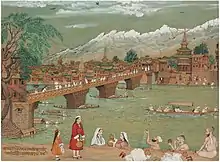

Early modern
Modern
D.L. Sheth, the former director of the Center for the Study of Developing Societies in India (CSDS), lists Indian communities that constituted the middle class and were traditionally "Urban and professional" (following professions like doctors, lawyers, teachers, engineers, etc.) immediately after Independence in 1947. This list included the Kashmiri Pandits, the Nagar Brahmins from Gujarat; the South Indian Brahmins; the Punjabi Khatris, and Kayasthas from northern India; Chitpawans and CKPs (Chandraseniya Kayastha Prabhus) from Maharashtra; the Probasi and the Bhadralok Bengalis; the Parsis and the upper crusts of Muslim and Christian communities. According to P.K.Verma, "Education was a common thread that bound together this pan Indian elite" and almost all the members of these communities could read and write English and were educated beyond school.[24][25][26]
Recent events
Exodus from Kashmir (1989–1995)
The Kashmiri Pandits had been a favoured section of the population of the valley during Dogra rule (1846–1947). 20 per cent of them left the valley as a consequence of the 1950 land reforms,[27] and by 1981 the Pandit population amounted to 5 per cent of the total.[28]
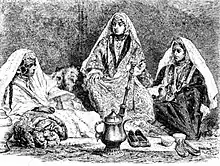
They began to leave in much greater numbers in the 1990s during the eruption of militancy, following persecution and threats by radical Islamists and militants. The events of 19 January 1990 were particularly vicious. On that day, mosques issued declarations that the Kashmiri Pandits were Kafirs and that the males had to leave Kashmir, convert to Islam or be killed. Those who chose to the first of these were told to leave their women behind. The Kashmiri Muslims were instructed to identify Pandit homes so they could be systematically targeted for conversion or killing.[29]
According to a number of authors, approximately 100,000 of the total Kashmiri Pandit population of 140,000 left the valley during the 1990s.[30] Other authors have suggested a higher figure for the exodus, ranging from the entire population of over 150,000,[31] to 190,000 of a total Pandit population of 200,000,[32] to a number as high as 800,000.[33] The nature of the planned exodus has remain controversial, with the involvement of then Governor Jagmohan in organising a clandestine exodus been a subject of controversy.[34] Many of the refugee Kashmiri Pandits have been living in abject conditions in refugee camps of Jammu.[35] The government has reported on the terrorist threats to Pandits still living in the Kashmir region.[36][37]
Some Hindus across India tried to help the Pandits. Bal Thackeray from Maharashtra got seats reserved in engineering colleges for the children of these Pandits. He was one of the first persons to help them after which Punjab also followed suit.[38][39][40]
In 2009 the Oregon Legislative Assembly passed a resolution to recognise 14 September 2007, as Martyrs Day to acknowledge ethnic cleansing and campaigns of terror inflicted on non-Muslim minorities of Jammu and Kashmir by terrorists seeking to establish an Islamic state.[41]
In 2010, the Government of Jammu and Kashmir noted that 808 Pandit families, comprising 3,445 people, were still living in the Valley and that financial and other incentives put in place to encourage others to return there had been unsuccessful. According to a J&K government report, 219 members of the community had been killed in the region between 1989 and 2004 but none thereafter.[42] The local organisation of pandits in Kashmir, Kashmir Pandit Sangharsh Samiti after carrying out a survey in 2008 and 2009, said that 399 Kashmiri Pandits were killed by insurgents from 1990 to 2011 with 75% of them being killed during the first year of the Kashmiri insurgency.[43][44]
The exiled community had hoped to return after the situation improved. They have not done so because the situation in the Valley remains unstable and they fear a risk to their lives.[45]
As of October 2015, only 1 Kashmiri Pandit family returned to the Kashmir valley since 1990 according to the Jammu & Kashmir government despite the financial assistance being given for rehabilitation.[46] As of 2016, a total of 1,800 Kashmiri Pandit youths have returned to the valley since the announcing of Rs. 1,168-crore package in 2008 by the UPA government.[47]
PRC and the JKMIP Acts
There are zones set up with offices for relief.[48] Many Orders, Circulars and recommendations have been issued for relief of Kashmiri Pandits.[49][50][51]
The Jammu And Kashmir Migrant Immovable Property (Preservation, Protection And Restraint on Distress Sales) Act, 1997, provides that "Any person who is an unauthorised occupant or recipient of any usufruct of any immovable property of the migrant shall pay to the migrant such compensation for the period of unauthorised occupation and in such a manner as may be determined by the District Magistrate."[52]
Socio-political organisations
Following the migration of the Kashmiri Pandit community, various socio-political organisations have sprung up to represent the cause of the displaced community. The most prominent among these are the All India Kashmiri Samaj or AIKS, All India Kashmiri Pandit conference, Panun Kashmir & Kashmiri Samiti. These organisations are involved in rehabilitation of the community in the valley through peace negotiations, mobilisation of human rights groups and job creation for the Pandits.[53]
Panun Kashmir has made demands for a separate homeland for the community in the southern part of Kashmir.[54] Ikkjutt Jammu, a political party in Jammu and Kashmir, advocates for two Union Territories in Kashmir, one being Panun Kashmir for Kashmiri Hindus.[55]
Population distribution

According to the 1941 census, there were 78,800 Kashmiri Pandits in the Kashmir Valley.[56][57] They were distributed into the two districts of Valley, the Baramulla district, where Hindus constituted 2.1 percent of the population; 12,919 Hindus out of 612,428 total.[58] and the Anantnag district, where they were 7.84 percent of the population.[59]
Scholar Christopher Snedden states that the Pandits made up about 6 per cent of the Kashmir Valley's population in 1947.[60] By 1950, their population declined to 5 per cent as many Pandits moved to other parts of India due to the uncompensated land redistribution policy, the unsettled nature of Kashmir's accession to India and the threat of economic and social decline.[27][28]
In the 1981 census, the Kashmir Division had 124,078 Hindus, the majority of whom were Pandits.[61] Scholar Alexander Evans estimates by 1990, there would have been 160,000–170,000 Pandits in the Kashmir Valley.[56]
Following the 1989 insurgency, a great majority of Pandits felt threatened and left the Kashmir Valley for other parts of India. A large number settled in the Jammu Division of the State and the National Capital Region of India. Some emigrated to other countries entirely.[9][60] By 2011, only an estimated 2,700-3,400 Pandits remained in the Kashmir Valley.[10]
According to Indian government, more than 60,000 families are registered as Kashmiri migrants including some Sikh and Muslim families.[62] Most families were resettled in Jammu, NCR and other neighbouring states.[63]
Society and culture
Religious beliefs
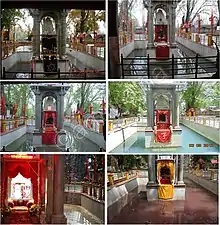
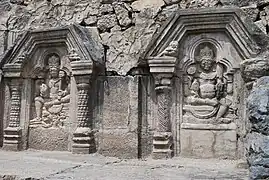
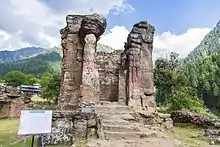
Kashmir has also been a land of Sun worship with shrines such as Martand Sun Temple established by Lalitaditya Muktapida. Sun worship is believed to have been brought into Kashmir by Kushan kings from Iran. Lalitaditya's predecessor, Ranaditya, is said to have built the first sun temple.[64] Wanvun singing is an integral part of Kashmiri Pandit religious ceremonies.
Pilgrimage sites
Harmukh is traditionally revered by Kashmiri Pandits and in 2009 there was an attempt by them to revive pilgrimages to the site.[65] The Mata Kheerbhawani[66] temple shrine in Srinagar, considered one of the holiest Hindu shrines, saw the largest gathering of Kashmiri Pandits in the Kashmir valley in 2012.[67] The shrine is located in Tullamulla village, 24 km from Srinagar in Ganderbal district.[68]
Festivals
The Kashmiri Pandits festivals include Shivratri (or Herath in the Kashmiri language) which is one of the major festivals of Kashmiri Pandits. Navreh or the Kashmiri lunar new year is also an important Pandit festival.[69]
Culture
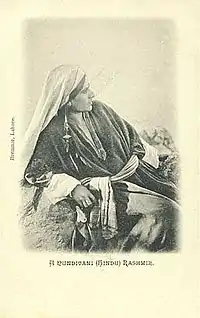
Dress
Kshemendra's detailed records from the eleventh century describe many items of which the precise nature is unknown. It is clear that tunics known as kanchuka were worn long-sleeved by men and in both long- and half-sleeved versions by women. Caps were worn, as well as a type of turban referred to as a shirahshata, while footwear consisted of leather shoes and boots, worn with socks. Some items were elaborate, such as the peacock shoes – known as mayuropanah – worn by followers of fashion, and steel-soled shoes adorned with floral designs, lubricated internally with beeswax.[70] They also wear the mekhalā, which is a type of girdle.[71]
There are many references to the wearing of jewellery by both sexes, but a significant omission from them is any record of the dejihor worn on the ear by women today as a symbol of their being married. Kaw has speculated that this item of jewellery may not have existed at the time. The texts also refer to both sexes using cosmetics, and to the women adopting elaborate hairstyles. Men, too, might adopt stylish arrangements and wear flowers in their hair, if they had the financial means to do so.[72]
Music
Henzae is an ancient traditional form of singing practised by Kashmiri Pandits at their festivals. It appears to have archaic features that suggest it is the oldest form of Kashmiri folk singing.[73][74]
Diet
The Kashmiri Pandits have a tradition of consuming meat, including mutton and fish, but they obey restrictions laid down by the shastras of not eating the meat of forbidden animals such as beef and pork.[71] Frederick J. Simoons says that according to some reports, Kashmiri Pandits also consume fish as part of their diet.[75]
Subcastes
The Kashmiri Pandits are divided into three subcastes: Guru/Bāchabat (priests), Jotish (astrologers), and Kārkun (who were historically mainly employed by the government). All three subcastes interdine and interteach, but only the Jotish and Kārkun subcastes intermarry.[22]
Krams
Kashmiri Hindus are Saraswat Brahmins and are known by the exonym Pandit.[76][77][78][79] Kashmiri Hindus society reckons descent patrilineally. Certain property and titles may be inherited through the male line, but certain inheritances may accrue through the female line.[80]
Some prominent Kashmiri Pandit krams include:
- Bhat or Bhatt[81][82][83][84]
- Dhar[82][83][84][85]
- Lone[84]
- Kaul[86]
- Raina[76][87]
- Kak[85][87]
- Kachru[85]
- Kichlu[87]
- Mantu/Mantoo/Mintoo[84]
- Haksar[87]
- Handoo[87]
- Ganai[84]
- Tikoo[86][85]
- Tantray[84]
- Mattoo[87]
- Pandit[83][85]
- Rajguru
- Bhan[85][87]
- Bakshi[87]
- Bazaz[87]
- Rather[84]
- Razdan[85][87]
- Munshi[85][87]
- Sapru[85][87]
- Zutshi[87]
- Magre/Magray[84]
- Yatoo[84]
- Wali[87]
- Wazir[87]
- Madan[85]
- Wain
Notable Kashmiri Pandits
- Motilal Nehru, lawyer and leader of Indian National Congress[88]
- Jawaharlal Nehru, former Prime Minister of India[88]
- Indira Gandhi, former Prime Minister of India[88]
- Vijaya Lakshmi Pandit, politician and diplomat[88]
- P. N. Haksar, bureaucrat and diplomat[89]
- Tej Bahadur Sapru, freedom fighter, lawyer, and politician[90]
- Tapishwar Narain Raina, ninth Chief of the Army Staff of Indian Army[91]
- Sanjiv Bhatt, Indian Police Service officer of the Gujarat-cadre[92]
- Raaj Kumar, actor[93]
- Anupam Kher, actor [94]
- Kunal Khemu, actor[95]
- Mohit Raina, actor[96]
- Rajendranath Zutshi, actor[97]
- Manav Kaul, actor[98]
- Suresh Raina, Indian cricketer[99]
- R. N. Kao, founder and first secretary of R&AW[100]
- Mohan Lal Zutshi, traveler, diplomat, and author, and an important player in the Great Game.[101]
- Sampat Prakash, trade union leader.[102]
- Samay Raina, Indian stand-up comedian[103]
See also
References
- Singh, Devinder (21 November 2014). "Reinventing Agency, Sacred Geography and Community Formation: The Case of Displaced Kashmiri Pandits in India". The Changing World Religion Map. Dordrecht: Springer Netherlands. pp. 397–414. doi:10.1007/978-94-017-9376-6_20. ISBN 9789401793759.
- "Protection Aspects of Unhcr Activities on Behalf of Internally Displaced Persons". Refugee Survey Quarterly. 14 (1–2): 176–191. 1995. doi:10.1093/rsq/14.1-2.176. ISSN 1020-4067.:The mass exodus began on 1 March 1990, when about 250,000 of the 300,000 Kashmiri Pandits fled the State
- Yong, Amos (2011). "Constructing China's Jerusalem: Christians, Power, and Place in Contemporary Wenzhou - By Nanlai Cao". Religious Studies Review. 37 (3): 236. doi:10.1111/j.1748-0922.2011.01544_1.x. ISSN 0319-485X.
- Casimir, Michael J.; Lancaster, William; Rao, Aparna (1 June 1997). "Editorial". Nomadic Peoples. 1 (1): 3–4. doi:10.3167/082279497782384668. ISSN 0822-7942.:From 1947 on, Kashmir's roughly 700,000 Hindus felt increasingly uneasy and discriminated against, and youth … from a variety of sources such as Islamist organizations, Islamic countries, Kashmiri Muslim fund raisers in the West, and migrant labor from Azad Kashmir in the …
- Sarkaria, Mallika Kaur (2009). "Powerful Pawns of the Kashmir Conflict: Kashmiri Pandit Migrants". Asian and Pacific Migration Journal. 18 (2): 197–230. doi:10.1177/011719680901800202. ISSN 0117-1968. S2CID 145137184.:… of the Centre of Central Asian Studies, Kashmir University, and member of Panun Kashmir (a Pandit … the Valley in 1990, believes "it could be anything between 300,000 to 600,000 people
- PTI. "30 years on, return to homeland eludes Kashmiri Pandits". Retrieved 19 April 2019.
- Duchinsky, Haley (26 September 2013). "Survival is now our Politics: Kashmiri Hindu community identity and the Politics of Homeland". International Journal of Hindu Studies. academia.edu. 12 (1): 41–64.
- Brower, Barbara; Johnston, Barbara Rose (2016). Disappearing Peoples?: Indigenous Groups and Ethnic Minorities in South and Central Asia. Routledge. ISBN 9781315430393.
Kashmiri Hindus are all Saraswat brahmins, known by the exonym Pandit (the endonym being Batta), a term first reserved for emigrant Kashmiri brahmins in Mughal service.
- Lyon, Peter (2008). Conflict between India & Pakistan: An Encyclopedia. Bloomsbury Academic. p. 99. ISBN 9781576077122.
- Essa, Assad (2 August 2011). "Kashmiri Pandits: Why we never fled Kashmir". aljazeera.com.
- Kaw, M. K. (2004). Kashmir and Its People: Studies in the Evolution of Kashmiri Society. APH. p. 183. ISBN 9788176485371.
- Siddhartha Gigoo, Varad Sharma (18 October 2016). A Long Dream of Home: The persecution, exile and exodus of Kashmiri Pandits. Bloomsbury Publishing. ISBN 9789386250254.
- Bamzai, Prithivi Nath Kaul (1994). Culture and political history of Kashmir, Volume 1. M.D. Publications Pvt. Ltd. pp. 191–192. ISBN 978-81-85880-31-0.
- Kaw, M. K. (2004). Kashmir and its people: studies in the evolution of Kashmiri society. Volume 4 of KECSS research series: Culture and heritage of Kashmir. APH Publishing. p. 90. ISBN 978-81-7648-537-1.
- Kaw, M. K. (2004). Kashmir and its people: studies in the evolution of Kashmiri society. APH Publishing. p. 91. ISBN 978-81-7648-537-1.
- Stein, Mark Aurel (1989) [1900]. Kalhana's Rajatarangini: a chronicle of the kings of Kasmir, Volume 1 (Reprinted ed.). Motilal Banarsidass. pp. 106–108. ISBN 978-81-208-0369-5.
- Hasan, Mohibbul (2005) [1959]. Kashmir Under the Sultans (Reprinted ed.). Delhi: Aakar Books. pp. 29–32. ISBN 978-81-87879-49-7.
- Hasan, Mohibbul (2005) [1959]. Kashmir Under the Sultans (Reprinted ed.). Delhi: Aakar Books. p. 34. ISBN 978-81-87879-49-7.
- Hasan, Mohibbul (2005) [1959]. Kashmir Under the Sultans (Reprinted ed.). Delhi: Aakar Books. p. 35. ISBN 978-81-87879-49-7.
- Davidson, Ronald M. (2004) [2002]. Indian Esoteric Buddhism: A Social History of the Tantric Movement (Reprinted (for SE Asia sale only) ed.). New York: Columbia University Press. pp. 70–71. ISBN 978-81-208-1991-7.
- Hasan, Mohibbul (2005) [1959]. Kashmir Under the Sultans (Reprinted ed.). Delhi: Aakar Books. pp. 28–95. ISBN 978-81-87879-49-7.
- Witzel, Michael (2008). "The Brahmins of Kashmir". In Rao, Aparna (ed.). The Valley of Kashmir. The making and unmaking of a composite culture?. Manohar. p. 37.
- Hasan, Mohibbul (2005) [1959]. Kashmir Under the Sultans (Reprinted ed.). Delhi: Aakar Books. pp. 87, 91–93. ISBN 978-81-87879-49-7.
- Pavan K. Varma (2007). The Great Indian Middle class. Penguin Books. p. 28. ISBN 9780143103257.
...its main adherents came from those in government service, qualified professionals such as doctors,engineers and lawyers,business entrepreneurs,teachers in schools in the bigger cities and in the institutes of higher education, journalists[etc]...The upper castes dominated the Indian middle class. Prominent among its members were Punjabi Khatris, Kashmiri Pandits and South Indian brahmins. Then there were the 'traditional urban-oriented professional castes such as the Nagars of Gujarat, the Chitpawans and the Ckps (Chandrasenya Kayastha Prabhus)s of Maharashtra and the Kayasthas of North India. Also included were the old elite groups that emerged during the colonial rule: the Probasi and the Bhadralok Bengalis, the Parsis and the upper crusts of Muslim and Christian communities. Education was a common thread that bound together this pan Indian elite...But almost all its members spoke and wrote English and had had some education beyond school
- "Searching for identity among Dalit middle class in Maharashtra". Social Action. Indian Social Institute. 50: 72. 2000.
- "D.L. Sheth".
- Zutshi, Languages of Belonging 2004, p. 318 Quote: "Since a majority of the landlords were Hindu, the (land) reforms (of 1950) led to a mass exodus of Hindus from the state. ... The unsettled nature of Kashmir's accession to India, coupled with the threat of economic and social decline in the face of the land reforms, led to increasing insecurity among the Hindus in Jammu, and among Kashmiri Pandits, 20 per cent of whom had emigrated from the Valley by 1950."
- K Pandita, Rahul (2013). Our Moon has Blood Clots: The Exodus of the Kashmiri Pandits. Vintage Books / Random House. p. 255. ISBN 9788184000870.
- Tej Kumar Tikoo, Kashmiri Pandits offered three choices by Radical Islamists, India Defence Review, 19 January 2015.
- Bose 1997, p. 71, Rai 2004, p. 286,Metcalf & Metcalf 2006, p. 274
- Malik 2005, p. 318
- Madan 2008, p. 25
- Noorani, A.G. (9 July 2016). "Kashmir's Pandits". Dawn.com. Dawn.
- "25 years after exodus of Kashmiri Pandits from the Valley, questions over return remain". Retrieved 27 January 2014.
- "BBC World Service | World Agenda - Give me land". Bbc.co.uk. Retrieved 28 March 2013.
- "23 years on, Kashmiri Pandits remain refugees in their own nation - Rediff.com India News". Rediff.com. 19 January 2012. Retrieved 28 March 2013.
- "India". Bureau of Democracy, Human Rights, and Labor, US Department of State. 6 March 2007.
- Navnita Behera (2000). State, Identity & Violence: Jammu, Kashmir, and Ladakh. Manohar Publishers & Distributors. p. 232.
- Ajit Chak (2000). Kashmir storm. Partridge. ISBN 9781482844351.
- Arvind Gigoo (2000). The Ugly Kashmiri: (Cameos in exile). Allied Publishers. ISBN 9798184240367.
- Senate Joint Resolution 23, 75th OREGON LEGISLATIVE ASSEMBLY—2009 Regular Session Archived 15 May 2013 at the Wayback Machine
- "Front Page : "219 Kashmiri Pandits killed by militants since 1989"". The Hindu. 24 March 2010. Archived from the original on 25 March 2010. Retrieved 28 March 2013.
- Azad Essa. "Kashmiri Pandits: Why we never fled Kashmir – Kashmir: The forgotten conflict". Al Jazeera English. Retrieved 3 August 2012.
- GreaterKashmir.com (Greater Service) (20 June 2011). "399 Pandits killed since 1990 KPSS Lastupdate:- Mon, 20 Jun 2011 18:30:00 GMT". Greaterkashmir.com. Retrieved 24 May 2012.
- Masih, Archana (29 April 2011). "The tragedy of Kashmiri Pandits (Part IV)". Rediff.com.
- Choudhary, Amit Anand (1 November 2015). "Only 1 Pandit family returned to Valley in 25 years". The Times of India. Retrieved 11 February 2021.
- Yasir, Sameer (19 January 2016). "When will we finally return home, ask displaced Kashmiri Pandits". Firstpost. Retrieved 11 February 2021.
- "Untitled Page". Retrieved 20 June 2016.
- "Untitled Page". Retrieved 20 June 2016.
- "Recommendations of Koul Committee" (PDF). Retrieved 21 May 2011.
- "Archived copy" (PDF). Archived from the original (PDF) on 23 July 2011. Retrieved 25 April 2011.
{{cite web}}: CS1 maint: archived copy as title (link) - "The Jammu Jammu And Kashmir Gazette" (PDF). Retrieved 21 May 2011.
- "Kashmiri pandit team to visit valley to negotiate for peace". The Indian Express. 16 May 2000.
- "Pandits to float Political Party". The Hindustan Times. 2 January 2007. Archived from the original on 5 October 2013.
- "Forget Delimitation; Divide Kashmir; Grant Statehood to Jammu: IkkJutt Jammu". The Northern Herald. 9 June 2021. Archived from the original on 10 July 2021.
- Evans, A departure from history (2002), p. 24.
- Census of India, 1941, Volume XXII, Parts I & II (1943), p. 11.
- Census of India, 1941, Volume XXII, Part III (1943), p. 271.
- Census of India, 1941, Volume XXII, Part III (1943), p. 345.
- Snedden, Christopher (2015), Understanding Kashmir and Kashmiris, Oxford University Press, ISBN 978-1-84904-342-7
- Evans, A departure from history (2002), pp. 24–25.
- "Cabinet approves the proposal to provide State Government jobs and transit accommodations in the Kashmir Valley for the rehabilitation of Kashmiri migrants". pib.nic.in. Retrieved 6 April 2018.
- "Rehabilitation of Kashmiri Pandits". pib.nic.in. Retrieved 6 April 2018.
- Bamzai, P. N. K. (1994), Culture and Political History of Kashmir, M.D. Publications Pvt. Ltd., p. 204, ISBN 978-81-85880-31-0
- "Gangbal yatra to commence after 100 yrs in Kashmir". Zeenews. 31 May 2009.
- "Kheer Bhawani Temple | District Ganderbal, Government of Jammu and Kashmir". Retrieved 7 March 2019.
- indianexpress.com, Srinagar (8 June 2009). "Valley divide impacts Kashmiri, pandit youth switch to devnagari".
- Biharprabha, News (29 May 2012). "Hindu Muslim unity depicted at Mata Khirbhawani temple in Kashmir".
{{cite web}}:|first=has generic name (help) - Ling, Huping (2008). Emerging Voices: Experiences of Underrepresented Asian Americans. Rutgers University Press. p. 135. ISBN 978-0-8135-4342-0.
- Kaw, pp. 94–95.
- Michael Witzel (September 1991). "THE BRAHMINS OF KASHMIR" (PDF): 44. Retrieved 25 January 2021.
{{cite journal}}: Cite journal requires|journal=(help) - Kaw, pp. 95–97.
- "Henzae: A Folk Genre Viewed Afresh". www.koausa.org.
- M. K. Kaw (2001). Kashmiri Pandits: Looking to the Future. APH Publishing. pp. 113–115. ISBN 978-81-7648-236-3.
- Frederick J. Simoons (1994). Eat Not this Flesh: Food Avoidances from Prehistory to the Present. University of Wisconsin Press. p. 284. ISBN 9780299142506.
There are even reports of certain Brahmin (Bengali Brahmins, Oriya Brahmins, Brahmins of certain parts of Bihar, Saraswat Brahmins of northern India, and Kashmiri Pandits) eating fish.
- Brower & Johnston 2016, p. 130: "Kashmiri Hindus are all Saraswat Brahmins, known by the exonym Pandit (the endonym being Batta), a term first reserved for emigrant Kashmiri Brahmins in Mughal service. Their surnames (kram) designate their original professions or their ancestors' nicknames (e.g., Hakim, Kaul, Dhar, Raina, Teng)."
- Kaw, M. K. (2001). Kashmiri Pandits: Looking to the Future. APH Publishing. p. 223. ISBN 978-81-7648-236-3.
The Kashmiri Pandits are the precursors of Kashmiri Muslims who now form a majority in the valley of Kashmir...Whereas Kashmiri Pandits are of the same ethnic stock as the Kashmiri Muslims, both sharing their habitat, language, dress, food and other habits, Kashmiri Pandits form a constituent part of the Hindu society of India on the religious plane.
- Bhasin, M.K.; Nag, Shampa (2002). "A Demographic Profile of the People of Jammu and Kashmir" (PDF). Journal of Human Ecology. Kamla-Raj Enterprises: 15. Retrieved 1 January 2017.
Thus the two population groups, Kashmiri Pandits and Kashmiri Muslims though at the time constituted ethnically homogenous population, came to differ from each other in faith and customs.
- Bhasin, M.K.; Nag, Shampa (2002). "A Demographic Profile of the People of Jammu and Kashmir" (PDF). Journal of Human Ecology: 16. Retrieved 1 January 2017.
The Sheikhs are considered to be the descendants of Hindus and the pure Kashmiri Muslims, professing Sunni faith, the major part of the population of Srinagar district and the Kashmir state.
- Brower & Johnston 2016, p. 130.
- The Journal of the Anthropological Survey of India, Volume 52. The Survey. 2003. Retrieved 2 December 2010.
The But/Butt of Punjab were originally Brahmin migrants from Kashmir during 1878 famine.
- Explore Kashmiri Pandits. Dharma Publications. ISBN 9780963479860. Retrieved 2 December 2010.
- Brower & Johnston 2016, p. 130: "Sheikh: local converts, subdivided into numerous subgroups. Most largely retain their family names, or patronyms (kram), indicating their original profession, locality or community-such as Khar (carpenter), Pampori (a place), Butt and Pandit (Brahmin), Dar (kshatriya)-but with increasing Islamization, some have dropped these"
- Proceedings - Indian History Congress, Volume 63. Indian History Congress. 2003. p. 867. Retrieved 30 December 2016.
...the Muslims also retained their Hindu caste-names known as Krams e.g. Tantre, Nayak, Magre, Rather, Lone, Bat, Dar, Parray, Mantu, Yatoo.....
- Lawrence, Sir Walter Roper (2005). The Valley of Kashmir. Asian Educational Services. p. 304. ISBN 978-81-206-1630-1.
Among the leading Krams may be mentioned the following names:— Tikku, Razdan, Kak, Munshi, Mathu, Kachru, Pandit, Sapru, Bhan, Zitshu, Raina, Dar, Fotadar, Madan, Thusu, Wangnu, Muju, Hokhu, and Dulu.
- Schofield, Victoria (2003). Kashmir in conflict. I.B. Tauris & Co. p. 4. ISBN 1860648983. Retrieved 25 June 2012.
- Agrawal, Premendra (20 August 2014). Accursed & Jihadi Neighbour. Commercial Services. p. 86. ISBN 9788193051207. Retrieved 5 April 2023.
Meaning of surnames found on the Kashmiri Pandit tree: Bakaya, Sapru, Bakshi, Munshi, Wazir, Chalkbast, Bhan, Langar or Langroo, Wattal, Bazaz, Taimini, Mattu, Chak, Zalpuri, Khar, Hazari, Zutshi, Razdan, Tikhu, Kathju, sopori, Thussoo, Haksar, Raina, Waloo or Wali, Wantu/Wanchu, Gamkhwar, Kakh, Mushran, Sharga, Handoo, Gurtu, Kitchlu, and Ganjoo.
- Thomas-Symonds, Nicklaus (30 July 2010). Attlee: A Life in Politics. Bloomsbury Publishing. p. 182. ISBN 978-0-85771-066-6.
- Singh, Kuldeep (2 December 1998). "Obituary: P.N. Haksar". www.independent.co.uk. Retrieved 16 July 2013.
- Mohan Kumar (1981). Sir Tej Bahadur Sapru: a political biography. Vipul Prakashan. Retrieved 25 March 2007.
Even now there are many distinguished scholars of Persian among the Kashmiri Brahmins in India. Sir Tej Bahadur Sapru and Raja Narendranath to mention two of them.
- "Kashmiri Pandit soldiers to the fore". Hindustan Times. 12 February 2013. Retrieved 9 January 2021.
- @sanjivbhatt (14 April 2018). "985204040500957185" (Tweet). Retrieved 23 March 2022 – via Twitter.
- Taneja, Nidhima (8 October 2022). "Raaj Kumar—Bollywood prince left the police force to live a king-sized life in his white shoes". ThePrint. Retrieved 3 August 2023.
- "Anupam Kher to work for Empowerment of Kashmiri Pandit Community". Hindustan Times. 11 April 2009. Retrieved 2 July 2013.
as a member of the [Kashmiri Pandit] community
- "Kunal Khemu On Being Kashmiri Pandit: "I did Feel like an OUTSIDER Every now and Then But…"". Bollywood Hungama. 13 May 2019. Retrieved 3 August 2023.
- Shah, Shreya (18 August 2013). "Oh My God!". Verve. Retrieved 3 August 2023.
- "1st global Kashmiri Pandit Youth meet today". The Indian Express. 7 January 2012. Retrieved 2 June 2023.
- Tarannum, Asira (31 January 2016). "I have faith in my performance: Manav Kaul". Deccan Chronicle. Retrieved 2 June 2023.
- Mishra, Itishree (31 August 2015). "Raina is a very caring husband, says wife Priyanka". The Times of India. Retrieved 3 August 2023.
- "R N Kao remembered". ANI. 20 January 2022. Retrieved 9 May 2022.
- Dean, Riaz (2019). Mapping The Great Game: Explorers, Spies & Maps in Nineteenth-century Asia. Oxford: Casemate (UK). pp. 41, 57. ISBN 978-1-61200-814-1.
- "Sampat Prakash passed away : श्रीनगर में संपत प्रकाश का दिल का दौरा पड़ने से हुआ निधन , महबूबा ने tweet कर जताया दुःख". Punjab Kesari. 2 July 2023. Retrieved 2 July 2023.
- "'Standing up' for Kashmir". The New Indian Express. 23 January 2020. Retrieved 2 October 2023.
I come from a conservative Kashmiri Pandit family..
Bibliography
- Census of India, 1941, Volume XXII – Jammu and Kashmir, Parts I & II, The Ranbir Government Press, 1943
- Census of India, 1941, Volume XXII – Jammu and Kashmir, Part III (PDF), The Ranbir Government Press, 1943
- Bose, Sumantra (1997), The Challenge in Kashmir: Democracy, self-determination, and a just peace, New Delhi: Sage Publications, in association with The Book Review Literary Trust, ISBN 978-0-8039-9350-1
- Evans, Alexander (2002). "A departure from history: Kashmiri Pandits, 1990-2001". Contemporary South Asia. 11 (1): 19–37. doi:10.1080/0958493022000000341. S2CID 145573161.
- Madan, T. N. (2008), "Kashmir, Kashmiris, Kashmiriyat: An Introductory Essay", in Rao, Aparna (ed.), The Valley of Kashmir: The Making and Unmaking of a Composite Culture?, Delhi: Manohar. Pp. xviii, 758, pp. 1–36, ISBN 978-81-7304-751-0
- Malik, Iffat (2005), Kashmir: Ethnic Conflict, International Dispute, Karachi and Oxford: Oxford University Press. Pp. xxvi, 392, ISBN 0-19-579622-5
- Metcalf, Barbara; Metcalf, Thomas R. (2006), A Concise History of Modern India (Cambridge Concise Histories), Cambridge and New York: Cambridge University Press. Pp. xxxiii, 372, ISBN 0-521-68225-8.
- Rai, Mridu (2004), Hindu Rulers, Muslim Subjects: Islam, Rights, and the History of Kashmir, Princeton University Press/Permanent Black. Pp. xii, 335., ISBN 81-7824-202-8
- Zutshi, Chitralekha (2004), Languages of Belonging: Islam, Regional Identity, and the Making of Kashmir, C. Hurst & Co. Publishers, ISBN 978-1-85065-700-2
Further reading
- Bose, Sumantra (2005). Kashmir: roots of conflict, paths to peace. Harvard University Press. ISBN 978-0-674-01817-4.
- Shade, Chinar (19 November 2013), Sun Worship and Kashmir
- Zutshi, Chitraleka (2008). "Shrines, Political Authority, and Religious Identities in Late-Nineteenth and Early-Twentieth-century Kashmir". In Rao, Aparna (ed.). The Valley of Kashmir: The Making and Unmaking of a Composite Culture?. Delhi: Manohar. pp. 235–258. ISBN 978-81-7304-751-0.

